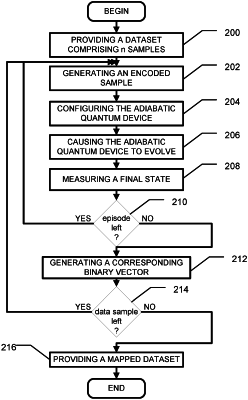| CPC G06F 16/22 (2019.01) [G06N 10/40 (2022.01)] | 20 Claims |

|
1. A computer-implemented method for mapping a dataset from a Hilbert space of a given dimension to a Hilbert space of a different dimension, the method comprising:
(a) obtaining a dataset D comprising n data samples xi, xi∈
 p for i∈{1,2, . . . , n}, wherein p is a dimension of each data sample; p for i∈{1,2, . . . , n}, wherein p is a dimension of each data sample;(b) for each of n data samples xi of the dataset D,
(i) for a plurality of episodes e,
(A) generating an encoded sample Ji=Axi+b, wherein A is a q×p matrix comprising elements drawn from a first distribution, wherein q is indicative of a number of qubits available in an adiabatic quantum device, and wherein b is a q-dimensional vector comprising elements drawn from a second distribution;
(B) configuring the adiabatic quantum device by embedding the encoded sample into a q-body Ising Hamiltonian H representative of the adiabatic quantum device and defined by:
 wherein a(t) and b(t) are classical external fields driving a Hamiltonian H(t) over the time span [0,T], wherein Hi is an initial Hamiltonian and Hf is a final or an encoding Hamiltonian defined, respectively, by:
 wherein σx, σz are Pauli-X and Pauli-Z operators, respectively, and wherein hl,m is a parameter defined as a function that depends on values ju e of the encoded sample;
(C) causing the adiabatic quantum device to evolve from an initial state at ti=0 to a final state at tf=t wherein t≤T; and
(D) performing a projective measurement along a z axis at the final state to determine a value of each qubit of the number of qubits of the adiabatic quantum device;
(ii) generating a corresponding binary vector representative of each data sample xi in a transformed Hilbert space using the value of each qubit at each episode e determined in (D), wherein the corresponding binary vector corresponds to a mapped data sample; and
(c) providing a mapped dataset comprising each of the corresponding binary vectors generated in (ii).
|